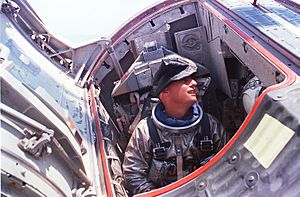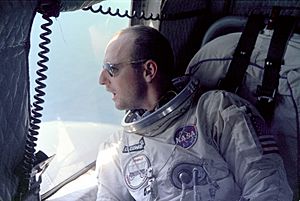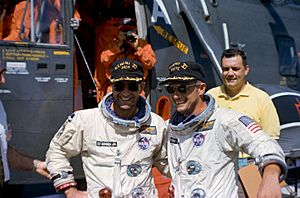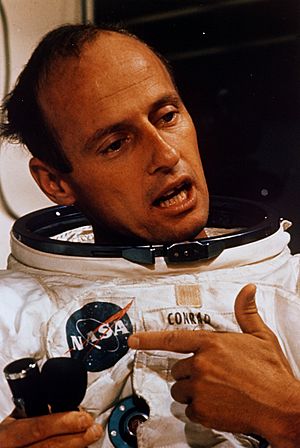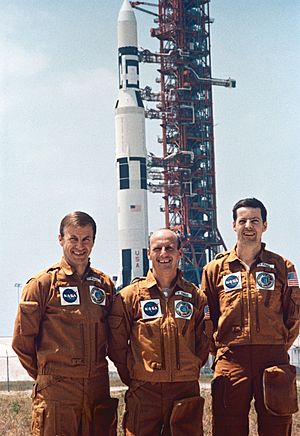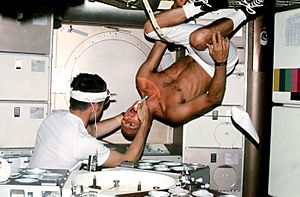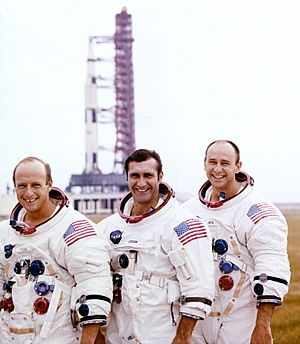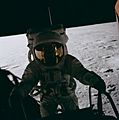Pete Conrad facts for kids
Quick facts for kids
Pete Conrad
|
|
|---|---|
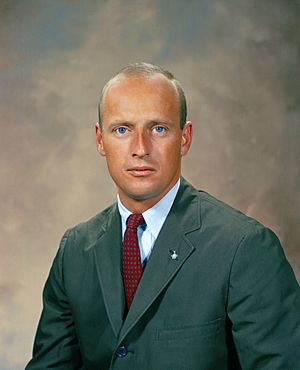
Conrad in 1964
|
|
| Born |
Charles Conrad Jr.
June 2, 1930 |
| Died | July 8, 1999 (aged 69) Ojai, California, U.S.
|
| Resting place | Arlington National Cemetery |
| Alma mater | Princeton University (BS, 1953) |
| Occupation | |
| Awards |
|
| Space career | |
| NASA astronaut | |
| Rank | Captain, United States Navy |
|
Time in space
|
49d 03h 38m |
| Selection | 1962 NASA Group 2 |
|
Total EVAs
|
4 |
|
Total EVA time
|
|
| Missions |
|
|
Mission insignia
|
|
| Retirement | December 1973 |
Charles "Pete" Conrad Jr. (born June 2, 1930 – died July 8, 1999) was an American NASA astronaut. He was also a naval officer, pilot, and test pilot. Pete Conrad commanded the Apollo 12 space mission. On this mission, he became the third person to walk on the Moon. NASA chose Conrad in 1962 as part of its second group of astronauts.
Conrad had dyslexia, a learning difference that makes reading and writing harder. Despite this, he earned a degree in Aeronautical Engineering from Princeton University. He was the first astronaut from an Ivy League school. After college, he joined the U.S. Navy. In 1954, he became a naval aviator. He served as a fighter pilot and later as a test pilot. In 1959, he was considered for the first group of astronauts for Project Mercury.
In 1965, Conrad set a space endurance record on his first spaceflight, Gemini 5. He flew with Gordon Cooper. Later, Conrad commanded Gemini 11 in 1966. He then commanded Apollo 12 in 1969, landing on the Moon. After his Moon mission, he commanded Skylab 2 in 1973. This was the first crewed mission to the Skylab space station. On this mission, he and his crew fixed serious damage to the station. For his bravery, President Jimmy Carter gave him the Congressional Space Medal of Honor in 1978.
Conrad left NASA and the Navy in 1973. He then worked for several companies, including McDonnell Douglas. He passed away on July 8, 1999, at age 69. His death was caused by injuries from a motorcycle accident.
Contents
Early Life and Education
Pete Conrad was born on June 2, 1930, in Philadelphia. He was the third child in his family. His family was well-off, involved in real estate and banking.
However, the Great Depression caused his family to lose their money. In 1942, they lost their large home. They moved into a smaller house, paid for by his uncle. Conrad's father, affected by their financial problems, later left the family.
Conrad was a smart boy but struggled with schoolwork. He had dyslexia, which was not well understood back then. He attended the Haverford School, a private school his family had always gone to. Even after his family lost money, his uncle helped him stay at Haverford. But Pete's dyslexia made school very hard. He failed most of his 11th-grade exams and was asked to leave the school.
Conrad's mother believed in him. She found him a new school, Darrow School in New Lebanon, New York. There, Conrad learned a "systems approach" to learning. This helped him work around his dyslexia. He had to repeat 11th grade, but he did very well at Darrow. After graduating in 1949, he got into Princeton University. He also received a full Navy ROTC scholarship. At Darrow, he was small but became the captain of his football team.
When he was 15, Conrad worked at Paoli Airfield. He did odd jobs like mowing lawns to earn airplane flights and lessons. He learned a lot about how aircraft and aircraft engines work. He even learned to do small repairs. At 16, he drove nearly 100 miles (160 km) to fix a plane that had made an emergency landing. He fixed it by himself. After that, the instructor gave him the lessons he needed to get his pilot's certificate. He earned it even before finishing high school.
Conrad kept flying in college. He maintained his pilot's certificate and earned an instrument flight rating. In 1953, he graduated from Princeton with a degree in aeronautical engineering. He wrote a long paper about designing a jet trainer. He then became an Ensign in the U.S. Navy.
After joining the Navy in 1953, Conrad went to Naval Air Station Pensacola, Florida, for flight training. He also trained in Naval Air Station Corpus Christi, Texas. In September 1954, he officially became a Naval Aviator and a fighter pilot. He was excellent in flight school. For several years, he flew fighter jets from aircraft carriers. Conrad also taught flying at Navy flight schools.
Next, Conrad applied to the United States Naval Test Pilot School in Patuxent, Maryland. He was accepted. His classmates included future astronauts Wally Schirra and Jim Lovell. He graduated in 1958 and became a Project Test Pilot. Conrad became a captain in the U.S. Navy on December 11, 1969.
During this time, Conrad was invited to try out for the first group of astronauts for NASA. This group was called the "Mercury Seven". Conrad, like others, went through many medical and psychological tests. He found these tests difficult and unnecessary. His first application to NASA was turned down. They wrote that he was "not suitable for long-duration flight."
After this, Conrad went back to the Navy as a fighter pilot. Later, NASA looked for a second group of astronauts. Alan Shepard, a Mercury astronaut who knew Conrad, convinced him to apply again. This time, the medical tests were better. In June 1962, Conrad was chosen to join NASA.
He flew for more than 6,500 hours. Over 5,000 of those hours were in jet aircraft.
NASA Career
Project Gemini
Conrad joined NASA on September 17, 1962. He was part of the second group of astronauts, known as the "New Nine." He was considered one of the best pilots. He was among the first in his group to get a Gemini mission. As pilot of Gemini 5, he and his commander Gordon Cooper set a new space endurance record. They stayed in space for 7 days, 22 hours, and 55 minutes. This was longer than the Russian record at the time. This flight length was important for future Moon missions. Conrad joked that the Gemini 5 capsule was "a flying garbage can."
Conrad tested many systems needed for the Apollo program. He was also one of the shortest astronauts, about 5 feet 6+1⁄2 inches (1.689 meters) tall. This made the small Gemini capsule less uncomfortable for him than for others. He then became the backup commander for Gemini 8. Later, he commanded Gemini 11 with pilot Richard Gordon. Gemini 11 connected with a target vehicle right after reaching orbit. This was a test for how the Apollo spacecraft would connect in space. The Gemini 11 flight also reached the highest Earth orbit ever for a crewed mission, at 1,369 kilometres (851 mi).
Apollo Program
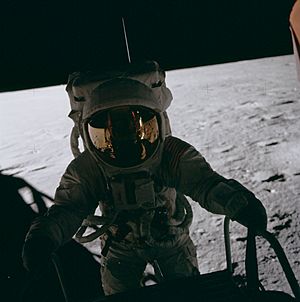
In December 1966, Conrad was assigned to command the backup crew for the first test flight of the full Apollo spacecraft. This included the Lunar Module (LM). Delays pushed this mission to December 1968 as Apollo 8. But when the LM was still not ready, NASA decided to send Apollo 8 to orbit the Moon without the LM. This moved Conrad's backup mission to Apollo 9 in March 1969. If these changes hadn't happened, Conrad might have commanded Apollo 11, the first mission to land on the Moon.
On November 14, 1969, Apollo 12 launched. Conrad was the commander. Dick Gordon was the Command Module Pilot, and Alan Bean was the Lunar Module Pilot. The launch was very challenging. Lightning strikes right after liftoff briefly knocked out power and guidance in the Command Module.
When Conrad stepped onto the Moon, he famously said, "Whoopee! Man, that may have been a small one for Neil, but that's a long one for me." He later said he said this to win a $500 bet with a journalist named Oriana Fallaci. She believed that Neil Armstrong's famous words were written for him. Conrad wanted to show that astronauts could say their own things. Conrad's "long one" referred to his jump from the ladder to the spacecraft's footpad. Armstrong's "small step" was from the footpad to the Moon's surface. Conrad's words for his first step on the Moon were "Oooh, is that soft and queasy."
One photo he took during the mission showed his own reflection in Al Bean's helmet visor. This picture was later called one of the best astronaut selfies.
Skylab
Conrad's last mission was as commander of Skylab 2. This was the first crew to live on the Skylab space station. The station was damaged during its uncrewed launch. Its shield tore off, taking one main solar panel and jamming another. Conrad and his crew fixed the damage during two spacewalks. Conrad used his strength to pull the stuck solar panel free, which he was very proud of. The astronauts also put up a "parasol" shield. This protected the station from the Sun's heat, a job the lost shield was supposed to do. Without this shield, Skylab would have become unusable. President Jimmy Carter honored Conrad for this in 1978 with the Congressional Space Medal of Honor.
During his training for Skylab 2, Conrad had to eject from his NASA T-38 jet on May 10, 1972. He was flying back to Houston. Due to bad weather, he had to change his landing plan. His plane lost power, and he ran out of fuel. He was forced to eject at 3,700 feet. He landed safely near an air base. His plane crashed in an open field a couple of miles away.
Post-NASA Career
Conrad retired from NASA and the Navy in 1973. He then started working for American Television and Communications Company. He was in charge of running their cable television systems.
In 1976, Conrad joined McDonnell Douglas, an aerospace company. He became a vice president. He was responsible for selling aircraft to both commercial and military customers. After a McDonnell Douglas DC-10 plane crashed in 1979, Conrad worked hard to reassure the public and save the plane's reputation. He was promoted several times within the company. In the 1990s, he also advised on the Delta Clipper project, an experimental spacecraft.
On February 14, 1996, Conrad was part of a team that set a record. They flew around the world in a Learjet in just over 49 hours. This jet is now on display at Denver International Airport.
A month before he passed away, Conrad appeared on ABC News Nightline. He talked about the value of the Space Shuttle. In his last interview, he discussed the future of space travel for the PBS show Nova. He thought returning to the Moon was a waste of money. Instead, he suggested missions to Mars and asteroids.
In 2006, NASA honored him after his death. He received the Ambassador of Exploration Award for his contributions to space and science.
Personal Life
While at Princeton, Conrad met Jane DuBose. Her family owned a large ranch in Uvalde, Texas. Her father was the first person to call him "Pete" instead of "Peter." Pete and Jane married on June 16, 1953, after he graduated and joined the Navy. They had four sons: Peter, Thomas, Andrew, and Christopher.
Because of his demanding career in the Navy and NASA, Pete and Jane spent a lot of time apart. Pete wished he could have seen his boys more as they grew up. Even after retiring, he stayed very busy. In 1988, Pete and Jane divorced. Both Pete and Jane later remarried.
In 1989, Conrad's youngest son, Christopher, became ill with a serious type of cancer. He passed away in April 1990, at age 29.
Conrad met Nancy Crane, a woman from Denver, through friends. Conrad and Crane married in 1990.
Conrad was a Cub Scout when he was young. He enjoyed golf, water skiing, and auto racing.
Death
Conrad passed away on July 8, 1999. He died from injuries he got in a motorcycle accident. He was riding with his wife and friends from his home in Huntington Beach to Monterey, California. His motorcycle crashed on a turn. Conrad later died in a hospital in Ojai. He was wearing a helmet and was driving within the speed limit. He was buried with full honors at Arlington National Cemetery. Many astronauts from the Apollo era attended his funeral.
The Lyndon B. Johnson Space Center in Houston, Texas, has a grove of trees. These trees honor astronauts who have passed away. After Conrad's death, NASA planted a tree for him. During the dedication, his Apollo 12 crewmate Alan Bean made a lighthearted speech. He pretended to "channel" Conrad's wishes from the afterlife. Bean said Conrad wanted his tree lit with colored lights every Christmas, not just white. This was to match Conrad's motto: "when you can't be good, be colorful." NASA has honored this "request." Every Christmas, all trees in the grove have white lights, except Conrad's, which has red lights.
Awards and Honors
- Two Navy Distinguished Service Medals
- Two Distinguished Flying Crosses
- Congressional Space Medal of Honor (1978)
- Two NASA Distinguished Service Medals
- Two NASA Exceptional Service Medals
- Yuri Gagarin Gold Space Medal (from the Fédération Aéronautique Internationale)
- Harmon Trophy (1974)
- Thompson Trophy (1974)
He is a member of several Aviation and Astronaut Halls of Fame. In 1980, he joined the National Aviation Hall of Fame. In 1982, he was one of ten Gemini astronauts inducted into the International Space Hall of Fame. Conrad and his fellow Gemini astronauts joined the U.S. Astronaut Hall of Fame in 1993. Princeton University gave him an Honorary Master of Arts degree in 1966. He also received honorary doctorates from other universities.
The three Skylab astronaut crews received the 1973 Robert J. Collier Trophy. This award was for showing "the value of man in future explorations of space." Gerald Carr accepted the 1975 Dr. Robert H. Goddard Memorial Trophy for the Skylab astronauts. They also received AIAA's 1974 Haley Astronautics Award.
Conrad was a fellow of several important groups. These included the American Astronautical Society and the American Institute of Aeronautics and Astronautics.
In Popular Media
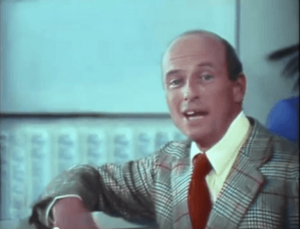
Conrad was featured in Tom Wolfe's 1979 book, The Right Stuff. This book was about test pilots and early astronauts. However, he was not in the 1983 film version. He played a news commentator in the 1975 TV movie, Stowaway to the Moon. He also played himself in the 1991 TV movie Plymouth, about a made-up lunar base. He even appeared in an American Express TV commercial.
In the 1995 film Apollo 13, David Andrews played Conrad. In the 1998 HBO miniseries From the Earth to the Moon, he was played by Peter Scolari and Paul McCrane. In the 2018 film First Man, Ethan Embry played him. In the 2019 TV series For All Mankind, Steven Pritchard played him.
Images for kids
See also
 In Spanish: Charles Conrad para niños
In Spanish: Charles Conrad para niños


